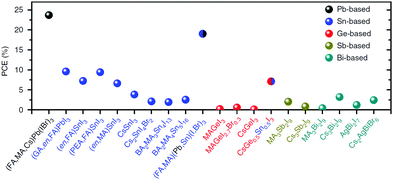Quote:
Originally Posted by Wolven

The claim is that the perovskite panels have potentially double the lifespan of the current solar panels (20 years -> 40 years). So in theory you get cheaper, more options for applications, and longer lifespan and for the same energy capture rate or better. Remember, not just flexible but also able to be transparent - every window in every building could become a solar panel.
It sounds like a massive step forward if they can figure out a few details.
Japan has started an RFP for companies to work with the government NEDO organization to develop the means to mass produce the next gen solar panels. Once mass production is solved it will be industry disruption time and with the amount of money Japan is throwing at this, I doubt it will be a long wait.
I am not sure what you are talking about with regard to lead... I do not see lead being mentioned in the new technology. |
Where are you seeing these claimed lifespans? Everything I've read about perovskite includes short life as a major limitation. There are many efforts to get around this, some promising, but I haven't read that it is a solved issue.
As to the lead, well, perovskites can be made of other elements, but the ones with lead are the only ones producing above 10% efficiency:

Quote:
|
Even if Pb-free perovskite solar cells were to attain the same efficiency and stability as Pb-based ones, their cost and total environmental impact must be carefully analysed together with their effects on human health and global availability. Sn-based perovskites or other Pb-free perovskites show intrinsic limitations in terms of stability and efficiency, and do not offer substantial advantages in terms of cost, toxicity or environmental safety; on the other hand, Pb is an abundant and cheap element with a much smaller environmental impact, and it can be easily recycled from multiple sources. Nevertheless, Pb poses intrinsic health risks calling for further research on safer and more environmentally friendly elements to partially substitute Pb without neglecting cost, availability constraints and environmental impact. In conclusion, research and technology should really balance the advantages of using Pb for renewable energy generation with the risks associated with its manufacturing.
|
https://pubs.rsc.org/en/content/arti.../tc/d0tc04552g
I guess I'm a little baffled how you can seem to know so much good stuff about them, but not have come across the lead issue.
Quote:
|
In addition to trapping the iodine compounds, these alumina nanoparticles helped form a more uniform structure while also forming a protective 2D layer, according to the researchers. When tested under levels of extreme heat and humidity (like those that’d be experienced outside the lab), the perovskites lasted two months, or roughly 1,530 hours—nearly a tenfold increase from the 160 hours endured by perovskites that weren’t enhanced with alumina.
|
https://www.popularmechanics.com/sci...el-holy-grail/
I'm not saying these issues won't be resolved, but I think this is a bit of cart before the horse thinking. The Canon stuff, and other articles talk about improving the lifespan, but I don't see any 20-40 years stuff using cheap easy to produce methods. Improved lifespan claims on something that has a really short life doesn't necessarily mean it now has a generally useful life. The world is littered with solar and battery ideas that were just about perfect, but their limitations prevent them from coming to market. This is on the "wait and see" pile.